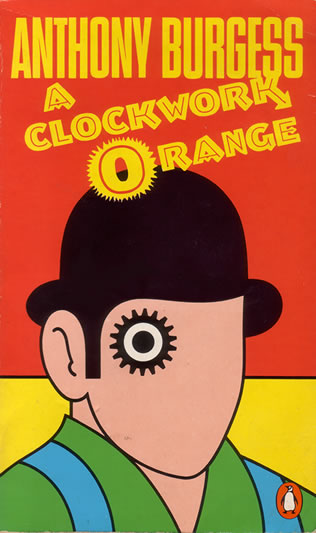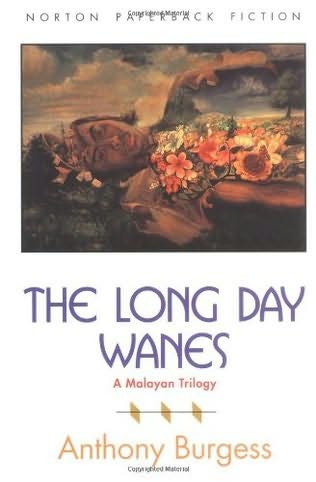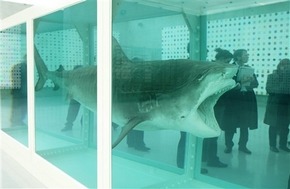 Was watching Hustle the other day, great BBC tv series about con men. Anyway the thing that caught my attention in the Designer's Paradise episode was the antagonist fashion designer reasoning about Charles Saatchi and a tiger shark in a tank which sold for 8mil. The name Charles Saatchi rang a bell as I recalled an ad agency named Saatchi & Saatchi wasn't sure if they were related. So what did this guy and a tiger shark in a tank and $12 million had to do with fashion/art.
Was watching Hustle the other day, great BBC tv series about con men. Anyway the thing that caught my attention in the Designer's Paradise episode was the antagonist fashion designer reasoning about Charles Saatchi and a tiger shark in a tank which sold for 8mil. The name Charles Saatchi rang a bell as I recalled an ad agency named Saatchi & Saatchi wasn't sure if they were related. So what did this guy and a tiger shark in a tank and $12 million had to do with fashion/art.Charles Saatchi was co founder with brother Maurice of the leading global advertising agency Saatchi & Saatchi. He is also known as an art collector and established the Saatchi Gallery in 1985. Charles Saatchi developed a strong interest in US pop culture during his early years in secondary school and had a strong enthusiasm for collections of Superman comics to Jukeboxes.
 In 1991 Charles Saatchi commissioned Damien Hirst for whatever artwork he wanted to create, thus the creation of "The Physical Impossibility of Death in the Mind of Someone Living" ~ a 14ft Tiger shark preserved in a tank filled with formaldehyde, total cost of work was £50,000. On December 2004 Charles Saatchi sold it to an American collector for $12 million (£6.5 million).
In 1991 Charles Saatchi commissioned Damien Hirst for whatever artwork he wanted to create, thus the creation of "The Physical Impossibility of Death in the Mind of Someone Living" ~ a 14ft Tiger shark preserved in a tank filled with formaldehyde, total cost of work was £50,000. On December 2004 Charles Saatchi sold it to an American collector for $12 million (£6.5 million).Damien Steven Hirst dominated the art scene in Britain during the 1990's, world renowned and reputed to be the richest living artist to date. His career in the 90's was closely linked with art collector Charles Saatchi whom commissioned him to create;
...which evidently became an iconic work of British art in the 90s and Brit Art world wide. Death is one of the themes in Damien Hirst's work, in which he was famous for a series of dead animals preserved in and sometimes dissected in formaldehyde.


Although he physically participated and the making of his earlier works it came to a point where the volume of work produced would require a factory setup where assistants will execute his ideas like a film director molds a film with the help of actors and a crew. Damien Hirst work philosophy wasn't much different than of Andy Warhol's that a legitimate art piece isn't the execution but the ideas and subject matter envisioned by the artist himself whom his assistants could execute it even better for him.
 Andrew Warhola more so known as Andy Warhol was leading figure in the Pop Art movement in America of the late 50's. He had a successful career as a commercial illustrator and was later recognized as a painter, filmmaker, record producer, author and a public figure.
Andrew Warhola more so known as Andy Warhol was leading figure in the Pop Art movement in America of the late 50's. He had a successful career as a commercial illustrator and was later recognized as a painter, filmmaker, record producer, author and a public figure. His studio dubbed The Factory was a place where he worked and to setup an assembly line for the mass production of his silkscreen works as well as a place a where prominent people hung out and the setting for most of his film making with the workers who doubled as actors.
His studio dubbed The Factory was a place where he worked and to setup an assembly line for the mass production of his silkscreen works as well as a place a where prominent people hung out and the setting for most of his film making with the workers who doubled as actors.Though more known as the Pope of Pop in the pop art movement for his works of Marilyn Monroe silk screen prints and Campbell Soup Can paintings, he was quite an underground filmmaker due to the controversial, explicit, abnormal films he made and the reason why it remained underground as non of the theaters wanted/could show them as for those that did usually got raided. Of such films, his 1965 film ~ Vinyl was a BWhite experimental film early adaption of the novel "A Clockwork Orange" by Anthony Burgess.
 John Burgess Wilson (pseudonym Anthony Burgess), an accomplished musician, author and linguist. Most known for his novel "A Clockwork Orange" which was adapted into film by Andy Warhol in 1965 and later in 1971 by Stanley Kubrik. The title of the novel came from an old Cockney expression, "as queer as a clockwork orange" and thought he could use it punningly to refer it to a mechanically responsive human due to his time in Malaya as a teacher and education officer for the British Colonial Service in 1954.
John Burgess Wilson (pseudonym Anthony Burgess), an accomplished musician, author and linguist. Most known for his novel "A Clockwork Orange" which was adapted into film by Andy Warhol in 1965 and later in 1971 by Stanley Kubrik. The title of the novel came from an old Cockney expression, "as queer as a clockwork orange" and thought he could use it punningly to refer it to a mechanically responsive human due to his time in Malaya as a teacher and education officer for the British Colonial Service in 1954.John Burgess Wilson was stationed at Kuala Kangsar, Perak and taught at the Malay Residential School, established in 1905 the first fully residential all boy all Malay prep school dubbed Eton of The East, founded by Mr R.J.Wilkinson and headed by then the headmaster of Penang Free School, Mr W.Hargreaves. Besides the languages
 German, Russian, French and Spanish, John Burgess Wilson was fluent in Malay speech and Jawi writing. In addition to his teaching duties he had responsibilities as a housemaster in charge of the students who were housed at a Victorian mansion known as the King's Pavilion.
German, Russian, French and Spanish, John Burgess Wilson was fluent in Malay speech and Jawi writing. In addition to his teaching duties he had responsibilities as a housemaster in charge of the students who were housed at a Victorian mansion known as the King's Pavilion. He devoted some free time to creative writing during his stay in Malaya and published his first novels ~ Time for a Tiger, The Enemy in The Blanket and Beds in The East was known as the Malayan trilogy and later published under a single volume The Long Days Wanes. In 1956, John Burgess Wilson composed the symphony ~ "Sinfoni Melayu", which draws on many musical styles he encountered while he was in Malaya, he described is as an attempt to "combine the musical elements of the country into a synthetic language which called on native drums and xylophones".
...End of the Line








17-12-41%5D.JPG)
17-12-55%5D.JPG)

